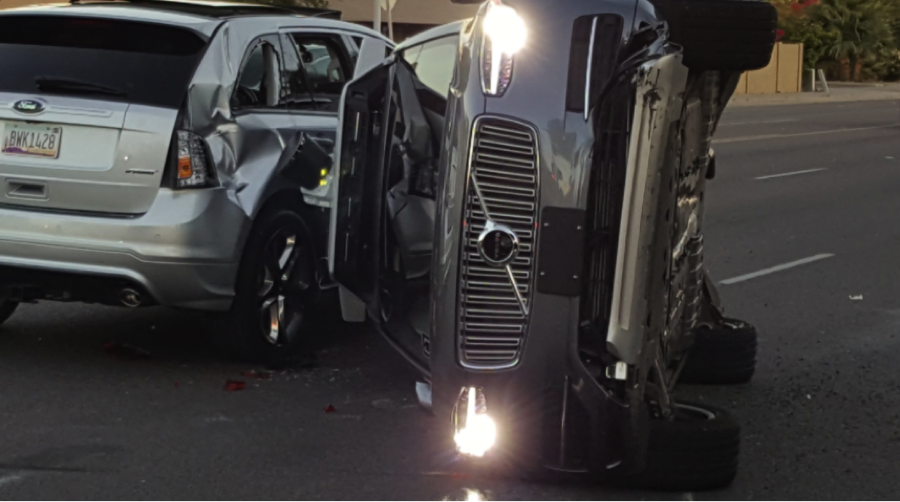March 29, 2017
Uber’s automated vehicles are back on the road following a collision in Tempe, Arizona last week when one of its self-driving vehicles was struck and rolled onto its side.
In the wake of the crash, Uber grounded its entire fleet of automated vehicles (AVs) operating in California, Pittsburgh, and Arizona in order to research the cause of the collision and assess whether it was safe to return the other cars in its fleet to public roads.
Uber’s vehicle, which was in self-driving mode at the time, had the right of way when a human driver failed to yield while making a left turn at an intersection. The human driver was deemed to be at fault and was issued a citation for failure to yield while making a left turn, according to Wired.
While the photos of the vehicle were unsettling, Arizona police reported no injuries to the engineers in the Uber or the human driver in the other vehicle.

(Source: Fresco News, via Twitter)
For some time, AV advocates have expressed concern that realizing the significant benefits of life-saving safety technologies would be slowed by the deployment of immature technologies by AV developers – which could potentially result in significant harm to AV occupants and/or other road users.
And perhaps this was the reason why Uber partnered with Volvo, which has been recognized as one of the world’s safest auto manufacturers and has made a bold pledge that, by 2020, no occupants will be killed or seriously injured in its new vehicles.
Backing this assertion is a statement by Volvo’s CEO in 2015 that it would accept all liability for collisions when its vehicles are in self-driving mode.
(Asst. Ed. Note: This does not apply to Uber’s AV tests and deployments, which are conducted using Uber’s proprietary systems.)
Uber penned a deal with Volvo last August wherein the tech firm purchased 100 of the Swedish automaker’s XC90s and both companies agreed to contribute $300 million for Uber to equip the vehicles with its AV technology.
However, Uber’s ambitious AV project is not without its detractors.
In February of this year, an advocate for victims of traffic collisions, Jeremy Warriner, launched the Safe Autonomous Vehicles (SAVe) Campaign. This national coalition advocates for transparency and manufacturer accountability when operating AVs on public roads.
“Autonomous vehicles offer an incredible opportunity to reduce injuries and fatalities caused by car accidents. However, this is an industry that requires oversight and careful scrutiny,” said Warriner in a press release announcing the campaign’s launch. “Let’s remember that this is the same industry that brought us faulty airbags, dangerous ignition switches, hidden devices to conceal exhaust levels, and malfunctioning gas pedals, just to name a few.”
No stranger to controversy, Uber has had a particularly storied past with regulators. Since its inception several years ago, the bull-headed Silicon Valley giant has repeatedly battled cities and states alike for its ability to operate its rideshare services.
Over the years, Uber has contested, defied, and/or dismantled regulations that taxi and livery services were historically required to comply with (e.g., driver fingerprinting, obtaining medallions, registering with local governments).
Tensions were exacerbated last year after the company made a surprise announcement that it would launch its Self-Driving Uber service in San Francisco.

Anthony Levandowski, Uber’s head of self-driving operations, spearheaded the launch. But a kerfuffle between Levandowski and the state government over the semantics of its AV regulations led Uber to withdraw its vehicles within a matter of weeks. (Levandowski, as ETW has written previously, played a pivotal role in writing some of the nation’s first AV laws in Nevada (2011) and California (2012))
This led Uber to move its vehicles to Arizona after its governor, Doug Ducey (R), invited the company to test AVs in the state with minimal regulatory oversight.
Arizona, unlike California, does not require AV testers to undergo an exhaustive permitting process and does not require annual reports on vehicle performance or collisions. Nonetheless, despite its initial recalcitrance, Uber later returned two of its self-driving Volvos to California in early March after applying for and obtaining an AV testing permit.
California compliance notwithstanding, some safety advocates seized on the opportunity to criticize Uber’s AV program – even in the wake of the recent collision where a human driver was deemed to be at fault.
“Companies like Uber are using our public roads as their private laboratories,” said John Simpson of Consumer Watchdog in a press release. “There must be complete transparency and accountability about what they are doing, which clearly can threaten public safety.”
Simpson has called on Uber to sign onto the SAVe Campaign’s pledge to accept all responsibility for crashes caused by its AVs – and also to release any videos and/or technical data pertaining to the recent collision.
Uber was originally included in the group of eighteen AV developers that the SAVe Campaign approached for the pledge.
To date, only Volvo has signed on.
“Self-driving car manufactures and developers must accept responsibility when their automated and autonomous technologies fail,” said Simpson.
“If Uber is finally serious about becoming a responsible corporate citizen, Uber CEO Travis Kalanick must take the SAVe pledge immediately.”





